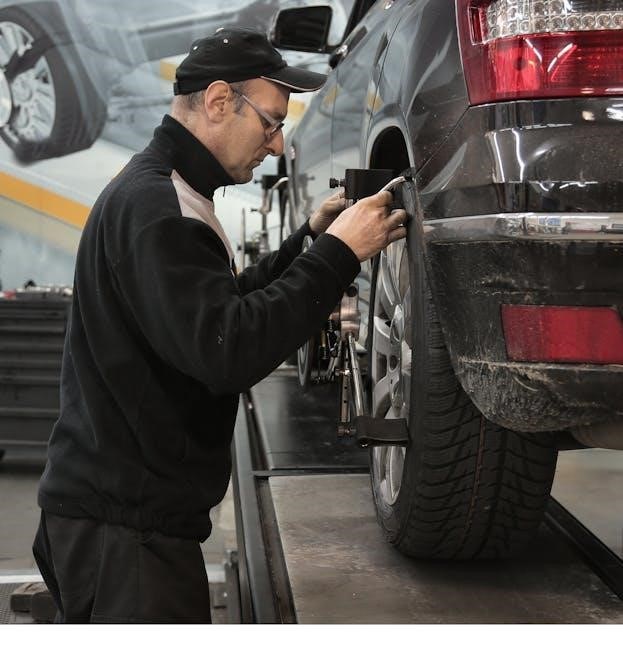Valve guides are critical engine components that direct valve stems, ensuring proper clearance and alignment. They prevent oil leakage and maintain efficient engine performance by guiding valve movement accurately.
What Are Valve Guides?
Valve guides are cylindrical components located in the cylinder head, responsible for directing the valve stems during engine operation. They ensure proper alignment and prevent excessive movement, which could lead to wear or damage. Guides also help prevent oil leakage into combustion areas by maintaining a tight seal around the valve stems. Properly functioning valve guides are essential for efficient engine performance and longevity.
Why Valve Guides Are Important
Valve guides play a crucial role in maintaining engine efficiency and preventing damage. They ensure valves operate smoothly, reducing wear on moving parts. Properly functioning guides prevent oil leakage into cylinders, which can cause engine contamination and reduced performance. Additionally, they maintain precise valve alignment, ensuring optimal combustion and minimizing the risk of costly repairs over time. Their importance cannot be overstated for overall engine health.

Tools and Equipment Needed
Specialized tools like valve guide drifts, reamers, and presses are essential for removing and installing guides. A heat source and lubricants are also necessary for the process.

Essential Tools for the Job
The process requires a valve guide drift for alignment, a reamer to ensure proper sizing, and a press or driver for installation. A heat source, like a heat gun, is necessary for fitting, while lubricants prevent damage during insertion. Proper tools ensure accuracy and prevent damage to engine components, making the replacement efficient and long-lasting.
Materials Required
New valve guides, compatible with your engine, are essential for replacement. High-temperature grease and lubricants prevent friction, while Never-Seize compound ensures long-term durability; A specialized drift aligns guides accurately, and reaming tools adjust the guide bore. Proper materials ensure a precise fit and prevent future wear. Engine oil and cleaning solvents also help maintain cleanliness during the process. Choosing the right materials ensures optimal performance and extends engine longevity.

Preparing for the Job
Preparing for the job involves heating the cylinder head to 200°C, cleaning the area around the old guides, and applying lubricant to ensure smooth removal.
Removing the Cylinder Head
Removing the cylinder head requires careful preparation. Start by draining the cooling system and disconnecting all connected components. Use a torque wrench to remove bolts in a star pattern to prevent warping. Once removed, place the head on a stable surface. Heating the head to 200°C can aid in loosening old guides. Clean the area thoroughly to prevent debris interference. Use specialized tools, like a drift, to remove guides without damaging the head. This step is crucial for a successful replacement.
Cleaning the Area
Thoroughly cleaning the area around the valve guides is essential before replacement. Use compressed air and solvent to remove dirt and old lubricant. Scrub the area with a wire brush to ensure a smooth surface for new guides. Proper cleaning prevents debris from interfering with installation. Ensure the cylinder head is free from contaminants to guarantee a precise fit and optimal performance. This step is vital for a successful valve guide replacement process.
Removing the Old Valve Guides
Removing old valve guides involves precise techniques such as drilling or applying heat to ensure safe extraction without damaging the cylinder head or surrounding components.
Methods for Removing Valve Guides
Several methods are used to remove old valve guides, including drilling, pressing, and heating. Drilling involves creating holes along the guide’s length for easy extraction. Pressing uses specialized tools to push out the guide gently. Heating the head and cooling the guide creates contraction, making removal easier. Each method requires precision to avoid damaging the surrounding engine components. Proper technique is essential for a successful replacement process.
Common Challenges and Solutions
Common challenges include stuck guides, improper alignment, and damage to surrounding areas. Applying heat or using penetrating oil can help loosen stuck guides. Ensuring proper alignment with specialized tools prevents misinstallation.Using the correct tools minimizes the risk of damage. Lubrication and careful handling are key to overcoming these challenges effectively, ensuring a smooth replacement process and maintaining engine integrity.
Installing the New Valve Guides
New valve guides are installed by heating the cylinder head and carefully aligning the guide using a drift. Proper fitting ensures smooth valve operation and prevents wear.
Proper Alignment and Fitting
Proper alignment ensures the new valve guide fits seamlessly into the cylinder head. Using specialized tools like a guide drift, align the guide with the valve seat for accurate placement. Heating the head beforehand allows the metal to expand, making installation easier. Once fitted, ensure the guide is square to the seat to maintain correct valve clearance and prevent engine damage. Proper fitting prevents wear and ensures smooth engine operation.
Ensuring Correct Clearance
Correct clearance between the valve stem and guide is vital for optimal engine performance. After installation, measure the clearance using a dial indicator or feeler gauges to ensure it meets manufacturer specifications. Proper clearance prevents excessive wear, overheating, and potential engine damage. If clearance is too tight or loose, adjust or replace the guide as needed to maintain precise fitment and ensure longevity of the valve train components.

Reassembly and Testing
After installing the new guides, carefully reassemble the cylinder head and test for leaks to ensure proper sealing and functionality. This step is crucial for optimal engine performance.
Reassembling the Cylinder Head
After replacing the valve guides, carefully reattach the cylinder head, ensuring all components are clean and properly aligned. Tighten bolts in the correct sequence and torque specification. Apply a thin layer of lubricant to moving parts to prevent wear. Double-check the valve train for proper clearance and function. Use specialized tools to ensure accuracy and avoid damage. This step requires precision to maintain engine performance and longevity.

Testing for Leaks
After reassembling, perform a thorough leak test to ensure the valve guides are sealed properly. Use a pressure test kit to check for any signs of air or fluid leakage around the guides. Visually inspect the area for oil droplets or coolant seepage. If leaks are detected, recheck the guide installation and seating. Proper sealing is crucial to prevent engine damage and maintain optimal performance over time.

Safety Precautions
Always handle hot engine parts with care to avoid burns. Use proper tools and protective gear, such as gloves and goggles, to ensure a safe working environment.
Handling Hot Engine Parts

When working with hot engine components, always use heat-resistant gloves and tongs to avoid burns. Allow parts to cool slightly before handling, as extreme heat can cause severe injuries. Proper ventilation is essential to prevent inhaling fumes. Keep a fire extinguisher nearby and ensure the workspace is clear of flammable materials. Safety should never be compromised during engine repairs. Always prioritize caution when dealing with heated components.
Using Proper Lubrication
Proper lubrication is crucial when replacing valve guides to prevent damage and ensure smooth operation. Apply a high-temperature grease to the new guides before installation, reducing friction and wear. Lubricate the valve stems as well to maintain optimal clearance and prevent overheating. Never use ordinary oils, as they may break down under high engine temperatures. Always follow manufacturer recommendations for suitable lubricants to guarantee longevity and performance of the valve train.
Choosing the Right Valve Guides

Selecting the correct valve guides ensures proper fitment and engine performance. Consider factors like material, diameter, and length to match your engine specifications. Research reputable manufacturers and compare products to find the best option for your needs and budget. Proper selection prevents future issues and ensures durability.
Factors to Consider
When selecting valve guides, consider the material, such as bronze or steel, for durability and heat resistance. The guide’s diameter and length must match the engine’s specifications. Proper clearance between the guide and valve stem is crucial for smooth operation. Additionally, choose guides compatible with your engine’s original design to ensure proper fitment and avoid modifications. Always consult the manufacturer’s specifications and engine manual for accurate measurements.
Recommended Manufacturers
When replacing valve guides, consider reputable manufacturers like ARP, Ferrea, and Victor Reinz, known for high-quality materials and precision engineering. These brands offer durable, heat-resistant guides designed for optimal performance. Ensure the manufacturer’s products are compatible with your engine’s specifications. Consulting forums and repair manuals can help identify trusted brands that meet your needs and budget, ensuring a reliable and long-lasting repair.
Cost and Time Considerations
The cost of replacing valve guides varies based on vehicle type and guide quality. The process typically takes several hours, depending on mechanical skill level.
Estimated Cost of Replacement
The cost of replacing valve guides varies depending on the vehicle and guide quality. Parts can range from $50 to $200 per set, while labor costs between $300 and $1,000. Tools like installers or drifts may add $50 to $150. DIY projects save on labor but require tools. Additional expenses may arise if other engine parts need repair. Shopping around and consulting a mechanic can provide a precise estimate for specific needs.
Time Required for the Process
Replacing valve guides typically takes 6 to 12 hours, depending on the mechanic’s experience and the vehicle’s complexity. For a DIY project, it may take longer, up to 20 hours, including disassembly, cleaning, and reassembly. Factors like the number of guides and additional repairs can extend the time. Proper planning and a well-organized workspace can help streamline the process, ensuring efficiency and reducing delays.
Common Mistakes to Avoid
Common mistakes include improper alignment, insufficient lubrication, and using incorrect tools. These errors can lead to damaged guides, engine wear, and costly repairs.
Incorrect Alignment
Incorrect alignment is a common issue when replacing valve guides. Misalignment can cause uneven wear, reduced engine performance, and increased risk of valve stem damage. Proper tools, such as alignment jigs, are essential to ensure the guide is perfectly square to the valve seat. Skipping this step may result in costly repairs and compromised engine efficiency. Always double-check the alignment before final installation.

Insufficient Lubrication
Insufficient lubrication during valve guide installation can lead to increased friction and premature wear. Always apply a high-quality lubricant, such as Never Seize, to the guide and surrounding area. This prevents metal-to-metal contact and ensures smooth operation. Neglecting lubrication can result in overheating, damage to the guide or valve stem, and costly repairs. Proper lubrication is essential for maintaining engine performance and longevity.
Changing valve guides demands careful preparation and precise installation to ensure engine efficiency and prevent issues. Regular maintenance is crucial for longevity.
Final Checks
After installing new valve guides, perform a thorough inspection to ensure proper alignment and fitment. Check for any signs of leakage or improper seating. Test engine performance under various conditions to confirm functionality. Verify that all tools and materials used are accounted for, and the workspace is clean. A final test drive can help identify any remaining issues. Always refer to manufacturer guidelines for precise validation. Proper completion ensures optimal engine operation and longevity.
Long-Term Maintenance
Regular engine inspections and oil changes are essential for maintaining valve guide health. Monitor for signs of wear, such as increased oil consumption or performance issues. Lubricate moving parts periodically to prevent friction and corrosion. Address any concerns promptly to avoid costly repairs. Proper maintenance ensures the longevity and efficiency of your engine. Consistent care will extend the life of your valve guides and overall engine performance.



